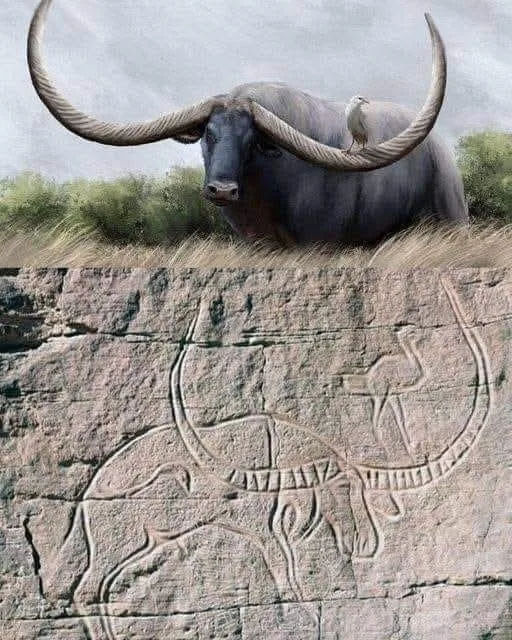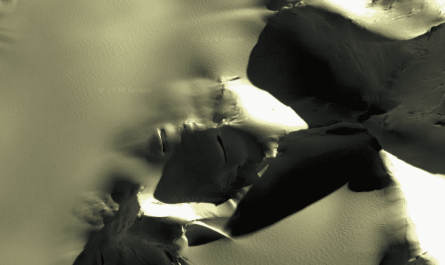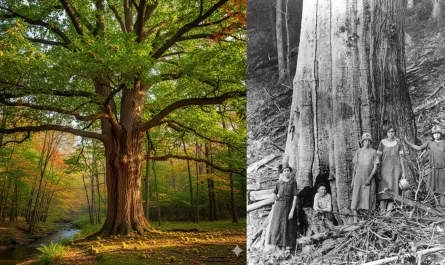In the heart of Libya’s Fezzan region, nestled within the rugged landscapes of the Messak Plateau, lies Wadi Mathendous, a prehistoric archaeological site that offers a window into a lost world. Among its many treasures is an 8,000-year-old petroglyph, a rock carving that captures a striking scene: the extinct Syncerus antiquus, an enormous African buffalo, with a delicate egret perched on one of its massive, sweeping horns. This ancient artwork, etched into the stone during the Neolithic period, not only showcases the artistic prowess of early humans but also immortalizes the largest bovid ever recorded in Africa—a giant whose horns could span nearly 10 feet from tip to tip. Join us as we explore the story behind this petroglyph, the majestic Syncerus antiquus, and the vibrant ecosystem that once thrived in a greener Sahara.

The Wadi Mathendous Petroglyph: A Glimpse into Prehistory
Wadi Mathendous, located in southwestern Libya, is renowned for its collection of prehistoric rock art, part of the broader Saharan rock art tradition that spans Algeria, Morocco, and Tunisia. Dating back to around 8,000 years ago (approximately 6000 BCE), the petroglyphs at Wadi Mathendous belong to the “Wild Fauna” or “Bubaline” period, a time when the Sahara was not the arid desert we know today but a fertile savanna teeming with life.
The petroglyph in question is a masterpiece of naturalistic engraving. It depicts Syncerus antiquus, a colossal buffalo, with an egret—likely a cattle egret—perched on one of its horns. The buffalo’s massive form dominates the scene, its horns curving gracefully outward and upward, while the small bird adds a touch of whimsy, hinting at a symbiotic relationship that mirrors modern cattle egrets perching on grazing animals to feed on disturbed insects. This artwork, carved with flint tools into the rock, captures not just the physicality of the animal but also a moment of ecological harmony, offering insight into the lives and observations of the people who created it.
Syncerus antiquus: The Giant Buffalo of Ancient Africa
Syncerus antiquus, often referred to as the African giant buffalo or long-horned buffalo, holds the distinction of being the largest bovid ever described from Africa. This extinct species, which roamed the continent during the Late Pleistocene and Holocene, was a true megafauna marvel, rivaling the American long-horned bison in size. According to paleontologist Auguste Pomel, who examined numerous fossils in Algeria, Syncerus antiquus measured up to 3 meters (9.8 feet) in length from muzzle to tail, stood 1.85 meters (6.1 feet) at the withers, and slightly less at the hindquarters. Its average weight was around 1,200 kilograms (2,600 pounds), with the largest males potentially reaching a staggering 2,000 kilograms (4,400 pounds).
The defining feature of Syncerus antiquus was its massive horns, with the largest horn cores reaching up to 3 meters (9.8 feet) from tip to tip—nearly 10 feet when covered with keratin in life. These horns, resembling those of the wild water buffalo (Bubalus arnee), curved outward and upward, forming a dramatic half-circle. Unlike its modern relative, the Cape buffalo (Syncerus caffer), Syncerus antiquus lacked the fused “boss” at the horn bases and had a longer, more antelope-like face. Its size and horn structure suggest it was adapted to wide-open savannas, where it grazed on large quantities of low-quality forage, as indicated by isotopic and mesowear evidence.
Fossils of Syncerus antiquus have been found across eastern, southern, and northern Africa, from South Africa to Algeria, with some evidence suggesting its presence in the Middle East. Rock art, including the Wadi Mathendous petroglyph, indicates it may have survived in North Africa until as recently as 4,000 years ago, outlasting its extinction in southern and eastern Africa around 12,000 years ago. The species’ broad distribution and its depiction in art suggest it was a significant part of prehistoric African ecosystems, likely living in large herds and serving as prey for predators like lions and hyenas.
The Egret: A Symbiotic Snapshot
The inclusion of an egret perched on the buffalo’s horn is a fascinating detail that speaks to the observational skills of the petroglyph’s creators. Likely a cattle egret (Bubulcus ibis), this bird is known for its symbiotic relationship with large herbivores, perching on their backs or horns to feed on insects stirred up by grazing. The petroglyph captures this behavior, suggesting that such ecological interactions were not only noticed but deemed significant enough to immortalize in stone. Some discussions on platforms like Reddit have speculated whether the bird could represent a stilt-legged species, but the consensus leans toward a cattle egret due to its recognizable behavior.
This detail adds a layer of cultural and ecological depth to the petroglyph. The artists, possibly early Berber peoples, were not merely depicting a buffalo but a moment of life—a snapshot of the interconnectedness of species in a lush, vibrant Sahara. The egret’s presence also underscores the fertility of the region during the African Humid Period (circa 12,000–5,000 years ago), when the Sahara supported grasslands, lakes, and a diverse array of wildlife, including giraffes, hippos, and rhinos.
The Cultural and Environmental Context
The Wadi Mathendous petroglyph is part of the Bubaline rock art tradition, characterized by large-scale, naturalistic engravings of wild animals. Created between 12,000 and 6,000 years ago, these artworks reflect a time when the Sahara was a savanna, not a desert. The African Humid Period, driven by climatic shifts after the last Ice Age, transformed North Africa into a fertile landscape with perennial lakes and abundant vegetation. This environment supported megafauna like Syncerus antiquus and the human communities that hunted and observed them.
The petroglyphs at Wadi Mathendous, along with others in the Maghreb region, often depict animals larger than life, with humans—typically hunters with spears—rendered smaller. This has been interpreted as a reflection of awe or fear inspired by these massive creatures, though the exact motivations remain speculative. Rock art across the Sahara, from Tunisia to Morocco, shows Syncerus antiquus being hunted, with some scenes depicting males ramming each other’s horns, suggesting ritualistic or territorial behaviors. These artworks not only document the buffalo’s presence but also hint at its cultural significance, possibly as a symbol of strength or a vital resource for early human societies.
The extinction of Syncerus antiquus is attributed to a combination of human predation and climatic changes, particularly the desertification of the Sahara around 6,000–5,000 years ago during the Piora Oscillation. As the region became arid, the buffalo’s habitat shrank, and populations in North Africa likely persisted longer in fertile pockets like the Atlas Mountains before vanishing around 4,000 years ago. Recent studies suggest possible genetic introgression of Syncerus antiquus into modern Cape buffalo populations in South Africa, indicating the species may have left a lasting legacy.
Why It Matters Today
The Wadi Mathendous petroglyph is more than an ancient artwork; it’s a testament to humanity’s enduring fascination with the natural world. It preserves the memory of Syncerus antiquus, a giant that once shaped African ecosystems, and offers a glimpse into a time when humans lived in close connection with megafauna. The egret perched on its horn reminds us of the intricate relationships that define ecosystems, a lesson that resonates in today’s era of conservation challenges.
For modern audiences, this petroglyph is a call to protect the giants that remain—species like the Komodo dragon or the African buffalo itself, which face threats from habitat loss and climate change. The extinction of Syncerus antiquus, driven partly by environmental shifts, serves as a warning of how quickly ecosystems can change and how vital it is to preserve biodiversity.
Exploring Further
To learn more about Syncerus antiquus and Saharan rock art, follow discussions on platforms like X, where posts from accounts like @archeohistories and @histories_arch highlight the Wadi Mathendous petroglyphs and their significance. For deeper dives, visit resources like the British Museum’s African Rock Art project or explore academic papers on ResearchGate for insights into the buffalo’s taxonomy and extinction. The Messak Plateau and Tadrart Acacus in Libya remain treasure troves of prehistoric art, waiting for those eager to uncover the stories etched in stone.
The Wadi Mathendous petroglyph stands as a bridge between past and present, a reminder of a world where giant buffalo roamed and egrets found perches on their mighty horns. It challenges us to imagine that lost Sahara and to protect the wonders that still remain.





